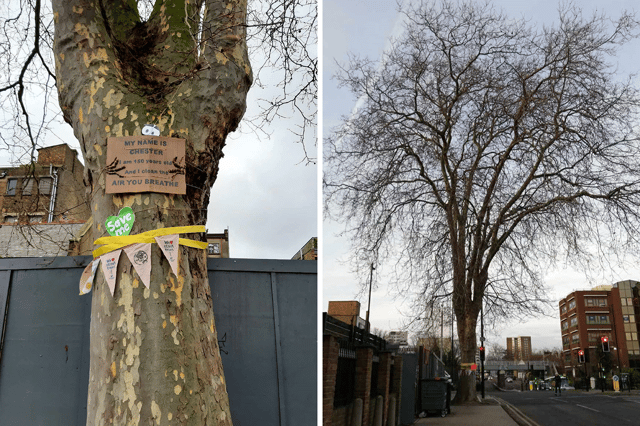Saving 'Chester': Fight to protect Southend-on-Sea's beloved plane tree from felling picks up steam


Residents of a seaside Essex city are preparing to do whatever they can to save a much-loved local tree, which the local council claims is a safety hazard.
A Change.org petition calling for Southend Borough Council to spare a 150-year-old London plane tree - known affectionately as 'Chester' by locals - has racked up more than 30,000 signatures in just over a month. The tree, which grows on Chichester Road in Southend-on-Sea, has attracted a crew of fierce defenders, who have decorated it and started a whole campaign to raise public awareness of its plight - and are also planning to march from the tree to the council offices in protest later this month.
Advertisement
Hide AdAdvertisement
Hide AdKaty Treverton, who started the petition, told NationalWorld the council say that Chester is taking up too much of the pavement with its roots, making it a health and safety issue for pedestrians. But she feared that the only alternative to cutting it down that they had looked into appeared to be buying the vacant land next door to the tree, and extending the pavement.
"Currently a motion has been put forward, and is being supported by several councillors, to look at changing the road layout and therefore keeping the tree. We are really hoping that the council seriously consider this option since you only need to speak with a few passers-by at the tree to realize that Southend residents really don't want to lose such a precious asset," she said.
According to the Woodland Trust, mature trees like Chester can absorb up to 48 pounds of carbon dioxide per year, she continued. They can also help to reduce urban runoff and erosion, by storing water and breaking rainfall.
After an information campaign to make sure locals knew what was happening, Ms Treverton said she had seen "incredible support" for saving Chester. "Many people comment how much they love the tree, since it is the only one on that particular busy road in the city centre. One resident commented that the tree had saved her multiple times when she was eight months pregnant, walking in the peak of summer."
Advertisement
Hide AdAdvertisement
Hide AdThe "amazing" number of people that had signed the petition had been really heartening, as were all of the lovely comments, she added. "People aren't silly - they know just how important this tree is and how vital it is we don't lose it, along with all the benefits it brings our city centre."
Southend Borough councillor Kevin Buck, the council's cabinet member for highways, transport and parking, said that they had now received a Tree Preservation Order for the London plane tree located on Chichester Road. "We will review this request in accordance with the council’s constitution. However, if the tree is found to pose a safety risk, the council will be obligated to remove it due to concerns for pedestrian safety and accessibility, particularly in a busy city centre location."
He continued: "While it's regrettable to remove any tree, some pose unacceptable risks to public safety. If a tree is deemed unsafe and requires removal on safety grounds, it would be irresponsible to delay this process longer than absolutely necessary."
The Woodland Trust's head of campaigning, Adam Cormack, told NationalWorld it was "critical" that local leaders did everything possible to retain healthy, mature trees like Chester. "These are the trees which work the hardest in terms of storing carbon, providing shade and improving quality of life for local residents," he said.
Advertisement
Hide AdAdvertisement
Hide AdThe neighbourhood where the plane tree was located had a level of tree canopy cover well below the national average, as shown by the Trust's new Tree Equity Score, he added. "The level of local opposition to the plans is something we've seen in many other places when much-loved trees are the subject of plans to remove them. We've also seen that it can be possible to retain trees by adjusting plans and good development design."
Amber Allott is NationalWorld’s environment and sustainability specialist, covering all things green - from climate to conservation. If you liked this article you can follow Amber on X (Twitter) here and sign up for the free daily NationalWorld Today newsletter here - with Amber bringing you the UK's most important, pressing, weird and wonderful environmental stories every Tuesday.
Comment Guidelines
National World encourages reader discussion on our stories. User feedback, insights and back-and-forth exchanges add a rich layer of context to reporting. Please review our Community Guidelines before commenting.
